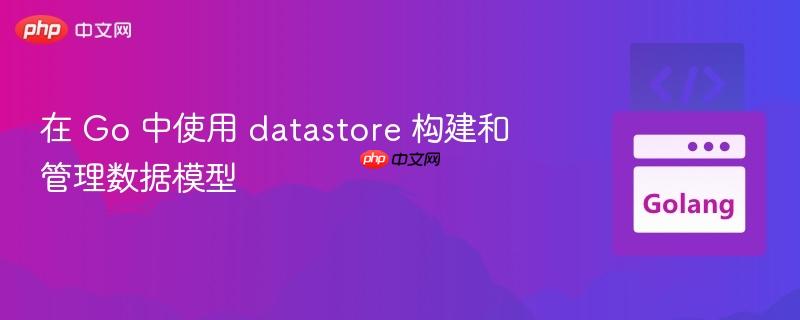
本教程详细介绍了如何在 go 语言中使用 `datastore` 构建和操作数据模型。我们将学习如何将 go 结构体映射为 `datastore` 实体,并通过 `datastore.newkey` 创建键,使用 `datastore.put` 存储数据,以及通过 `datastore.get` 加载数据,重点讲解 `kind` 的概念及其在数据操作中的关键作用。
在 Go 语言中与 Google Cloud datastore (或旧版 App Engine datastore) 交互时,数据模型的设计与传统关系型数据库(如 MySQL)有所不同。datastore 是一个 NoSQL 文档数据库,其数据以“实体”(Entities)的形式存储,每个实体都具有一个“种类”(Kind)、一个唯一标识符(ID 或名称)以及一组属性(Properties)。
Go 语言中的结构体(struct)是定义 datastore 数据模型的理想方式。每个结构体实例都可以直接映射为一个 datastore 实体,结构体的字段则对应实体的属性。关于是否需要将多个相关数据(如设备及其信息)嵌套在一个大型结构体中,datastore 的设计哲学通常倾向于将不同类型的数据定义为独立的结构体,每个结构体对应一个 Kind。datastore 通过键(Key)来引用实体,因此,即使数据之间存在逻辑上的父子关系或关联,也可以通过在键中指定父级或在实体中存储其他实体的键来实现,而不是强制将所有相关数据嵌套在一个结构体中。
Kind 的概念
Kind 是 datastore 中对实体进行分类的字符串名称,类似于关系型数据库中的表名。在 Go 语言中,通常将结构体的名称直接用作其对应 datastore 实体的 Kind。例如,User 结构体对应的 Kind 就是 "User"。这是 datastore 区分不同类型实体并进行查询和索引的基础。
为了在 datastore 中存储数据,我们首先需要定义 Go 结构体。这些结构体将作为 datastore 实体的蓝图。以下是几个示例结构体,它们清晰地定义了用户、设备和设备信息的数据结构:
package main
import (
"time"
)
// User 定义了用户数据模型
type User struct {
UserID int64 // 用户唯一ID,通常作为datastore的intID
Email string // 用户邮箱
Password string // 用户密码(通常应存储哈希值)
DateCreated time.Time // 创建日期
}
// Device 定义了设备数据模型
type Device struct {
DeviceID int64 // 设备唯一ID
Udid string // 设备UDID
DateCreated time.Time // 创建日期
DateUpdated time.Time // 更新日期
IntLoginTotal int // 登录总次数
}
// DeviceInfo 定义了设备详细信息数据模型
type DeviceInfo struct {
DeviceID int64 // 关联的设备ID
DeviceName string // 设备名称
Model string // 设备型号
LocalizedModel string // 本地化型号
SystemName string // 系统名称
SystemVersion string // 系统版本
Locale string // 区域设置
Language string // 语言
DateCreated time.Time // 创建日期
}在这些结构体中,字段类型通常与 datastore 支持的属性类型相对应。int64、string 和 time.Time 是 datastore 常用且直接支持的类型。
将 Go 结构体实例保存到 datastore 需要以下几个步骤:获取 appengine.Context、创建实体键 datastore.NewKey 和执行存储操作 datastore.Put。
所有 datastore 操作都需要一个 appengine.Context 实例。这个上下文用于跟踪请求的生命周期、传递认证信息等。在 App Engine 环境中,通常通过 appengine.NewContext(r) 从 HTTP 请求 r 中获取。
import (
"google.golang.org/appengine" // 注意:这是旧版App Engine的包路径
"net/http"
)
// 假设在一个HTTP处理函数中
func handler(w http.ResponseWriter, r *http.Request) {
c := appengine.NewContext(r)
// ... 后续datastore操作
}注意: 上述 google.golang.org/appengine 包主要用于旧版 App Engine Standard 环境。对于 Google Cloud Platform 上的 Go 应用程序(包括 App Engine Flexible 或其他计算服务),通常会使用 cloud.google.com/go/datastore 客户端库,并使用 context.Background() 或 context.WithTimeout() 等标准 Go context 包来创建上下文。本教程沿用原始问题中的 appengine.NewContext 示例,但请根据您的部署环境选择正确的上下文创建方式。
datastore 中的每个实体都由一个唯一的键(Key)标识。datastore.NewKey 函数用于构建这个键。

SmartB2B 是一款基于PHP、MySQL、Smarty的B2B行业电子商务网站管理系统,系统提供了供求模型、企业模型、产品模型、人才招聘模型、资讯模型等模块,适用于想在行业里取得领先地位的企业快速假设B2B网站,可以运行于Linux与Windows等多重服务器环境,安装方便,使用灵活。 系统使用当前流行的PHP语言开发,以MySQL为数据库,采用B/S架构,MVC模式开发。融入了模型化、模板
 0
0

func NewKey(c appengine.Context, kind, stringID string, intID int64, parent *Key) *Key
示例:存储一个用户实体
假设我们有一个 User 实例 u,并希望将其存储到 datastore 中。我们将使用 u.UserID 作为实体的整数 ID。
import (
"google.golang.org/appengine/datastore"
"time"
)
// 假设 userid, email, password, datecreated 已定义
// c := appengine.NewContext(r) // 从请求中获取上下文
// 1. 创建 User 结构体实例
u := &User{
UserID: 12345, // 假设的用户ID
Email: "test@example.com",
Password: "hashed_password",
DateCreated: time.Now(),
}
// 2. 使用 NewKey 创建一个完整的键
// Kind 为 "User",intID 为 u.UserID,无 stringID,无父实体
k := datastore.NewKey(c, "User", "", u.UserID, nil) // 注意:intID 参数是第三个,stringID是第二个,所以这里stringID留空
// 3. 将实体保存到 datastore
// datastore.Put 返回一个新的 Key (如果原始Key是不完整的) 和一个错误
_, err := datastore.Put(c, k, u)
if err != nil {
// 处理错误
return err
}
// 实体已成功保存从 datastore 加载数据同样需要 appengine.Context 和实体键 datastore.NewKey,然后使用 datastore.Get 函数。
与存储时类似,加载数据时也需要通过 datastore.NewKey 创建一个完整的键,以便 datastore 知道要检索哪个实体。键必须与存储时的 Kind 和 ID 完全匹配。
datastore.Get 函数用于根据提供的键从 datastore 中检索实体。
func Get(c appengine.Context, key *Key, dst interface{}) error示例:加载一个用户实体
假设我们知道一个用户的 UserID,并希望从 datastore 中加载其完整信息。
// 假设 userid 已知
// c := appengine.NewContext(r) // 从请求中获取上下文
// 1. 使用 NewKey 创建一个完整的键,与存储时保持一致
// Kind 为 "User",intID 为目标 userid
targetUserID := int64(12345) // 假设要加载的用户ID
k := datastore.NewKey(c, "User", "", targetUserID, nil)
// 2. 创建一个空的 User 结构体实例的指针,用于接收数据
retrievedUser := new(User)
// 3. 从 datastore 加载实体
err := datastore.Get(c, k, retrievedUser)
if err != nil {
// 处理错误,例如实体不存在 (datastore.ErrNoSuchEntity)
return err
}
// 实体已成功加载到 retrievedUser 中
// fmt.Printf("Loaded User: %+v\n", retrievedUser)通过本教程,我们了解了如何在 Go 语言中利用结构体定义 datastore 数据模型。核心流程包括:
datastore 提供了灵活且强大的数据存储能力,其无模式特性与 Go 结构体的结合,使得数据模型的定义和操作变得直观高效。理解 Kind 和键在 datastore 中的作用是成功构建和管理应用程序数据模型的关键。
以上就是在 Go 中使用 datastore 构建和管理数据模型的详细内容,更多请关注php中文网其它相关文章!

每个人都需要一台速度更快、更稳定的 PC。随着时间的推移,垃圾文件、旧注册表数据和不必要的后台进程会占用资源并降低性能。幸运的是,许多工具可以让 Windows 保持平稳运行。

Copyright 2014-2025 https://www.php.cn/ All Rights Reserved | php.cn | 湘ICP备2023035733号